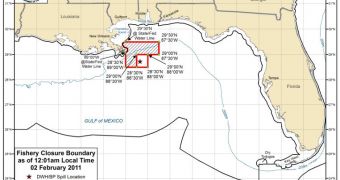Officials with the US National Oceanic and Atmospheric Administration (NOAA) announce that they reopened an additional 4,213 square miles of waters in the Gulf of Mexico to royal red shrimping.
All the reopened surface is located off the coast of Louisiana, in federal waters. The new decision significantly reduces the area that remains closed. In effect, only the surfaces around the site of last year's oil spill remain under federal lock-down.
According to experts at NOAA, the region that was now reopen was closed down on November 24, due to concerns that deep water fishing here could endanger the health of consumers back on land.
The decision was prompted by the fact that a commercial shrimper discovered tar balls in deep water fish nets. NOAA and other relevant federal agencies decided to play it safe, and forbid fishermen's access to the entire region until the oil dissipates.
In the mean time, chemists carried out a “fingerprint” analysis in the recovered tar balls, in order to determine whether they originated from the site of the BP/Deepwater Horizon oil spill. Oddly enough, the tests were inconclusive.
Additionally, studies carried out by scientists in this area revealed no further signs of contamination. Fish and other marine creatures caught here after November 24 turned out to be in normal health.
The semi-submersible drilling rig blew up on April 20, and sunk on April 22, 2010, killing 11 workers. In the coming weeks, it became apparent that the ensuing oil spill will become the largest ecological disaster in history.
As efforts to deal with the oil spill were ongoing, federal waters were closed to fishing. NOAA and the US Food and Drug Administration (FDA), together with the Environmental Protection Agency (EPA), were in charge of determining when and where to apply these measures.
The new decision to open the 4,213 square miles to all commercial and recreational fishing was also taken after discussions between NOAA and the FDA.
“Extensive testing of royal red shrimp and other fish from this area revealed they are safe to eat. Seafood safety and consumer confidence remain a priority for NOAA, and we will continue monitoring Gulf seafood for as long as necessary to ensure its integrity,” says Roy Crabtree.
The expert holds an appointment as the assistant NOAA administrator for the Administration's Fisheries Service southeast region.

 14 DAY TRIAL //
14 DAY TRIAL //